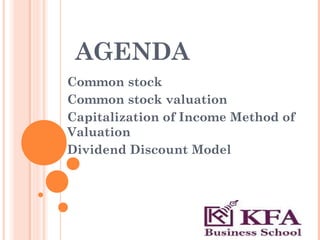
Investment
- 1. AGENDA Common stock Common stock valuation Capitalization of Income Method of Valuation Dividend Discount Model
- 2. COMMON STOCK Meaning:- It is a security that represent a share of ownership in a company. An individual or institutions who purchase the specific company`s common stock, s/he or they become shareholders. Company issue common stock to raise equity capital, which is the permanent source of capital. It does not have maturity vale.
- 3. COMMON STOCK VALUATION Par value:- par value of share reflects the legal price of the share. In other words, it is stated value in the common stock certificates. Book value:- The book value of a company is the accounting value of the stockholder`s equity which is known as balance sheet. It is the sum of common stock outstanding, capital in excess of par value, and retained earnings.
- 4. Liquidation value:- It is the value that a company could realize to sell its assets and distribute the proceeds to creditors and shareholders. Market value:- It is current quoted price to buy or sell the stock. Intrinsic value:- the intrinsic value or economic value of a share is the present value of the cash flows that the share will generate, discounted at the rate of return appropriate for the risk of the company.
- 5. Comparison Situation Decision Current Market Price ˃ Intrinsic Overpriced Sell or short sell Value Current Market Price ˂ Intrinsic Underpriced Buy Value Current Market Price = Intrinsic Correctly priced No action Value
- 6. CAPITALIZATION OF INCOME METHOD OF VALUATION Capitalization of Income Method:- It seeks to determine the value of a security by discounting all expected future cash flows using a required rate of return. It can be expressed mathematically as follows Po= D1 + D2 + D3 +………+ D∞ (1+k)¹ (1+k)² (1+k) ³ (1+k)∞
- 7. DIVIDEND DISCOUNT MODEL Meaning:- It refers the value the stock is the sum of all expected future dividend payments, where the dividends are adjusted for risk and the time value of money. There are three growth rate models for they are:- 1. Zero growth model 2. Constant growth model 3. Multiple growth model
